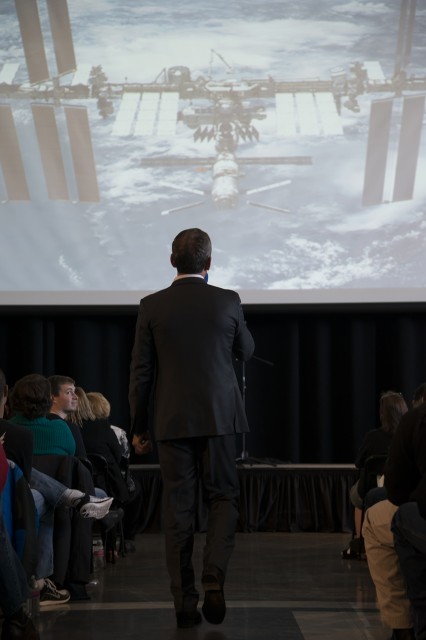
Col. Chris Hadfield describes life onboard the International Space Station to a packed house at the Future of Flight – Photo: Kris Hull
Colonel Chris Hadfield (RCAF ret.) is probably one of the most easily recognizable astronauts today. His popularity was spurred to rock star-like status in 2012 while he was training for his final spaceflight, a five-month stay on the International Space Station. Recently, Col. Hadfield made a stop in Everett, WA, to promote his newest book, You are Here ’“ Around the World in 92 Minutes, and AirlineReporter had a few minutes to sit down and talk with this amazing man about his missions, his infamous tweets, and his books.
In the last fifteen to twenty years, no astronaut has risen to the popularity that Chris Hadfield has. As one of the few Canadian astronauts, he has had the honor of flying into space three times: twice on the Space Shuttle, and once on a Soyuz. On his last mission, he assumed command of the International Space Station, only the second non-American or Russian to hold that honor. He was the only Canadian to visit the Russian space station Mir and was the first Canadian to walk in space.
When asked about his two space walks, and what it was like to exit that hatch for the first time, he said “It’s very visually powerful. It is overwhelmingly visually powerful outside. You have the Earth going by underneath you at five miles a second, and all of the colors that exist, the textures, are just amazing. When you look the other way, it is the complete blackness of the universe going on forever. And you are in the middle of all of this, hanging onto a silver and white man-made structure, holding on with one hand. The onslaught coming in through your eyes is amazing. Your eyes is the only sense that tells you were you are. It is an overwhelming experience. When I go back and watch the video of the first time I exited the hatch, I can see that I just stopped for several seconds and just took it all in. We over use the words awesome and incredible, but walking in space is both of these things.”
As a veteran of two space shuttle missions, STS-74 aboard Atlantis and STS-100 aboard Endeavour, as well as flying a Soyuz capsule to the International Space Station, he is commonly asked which spacecraft he prefers. “The question is better put as ‘which do you prefer? a moving truck or a smart car?” he said. “They are both intricately designed vehicles. I wouldn’t want a moving truck if I was only commuting to work, and I wouldn’t want a Smart Car if I was hauling a bunch of stuff around or needed a crew of six.
They are both amazing and well designed. One is smoother going up, and the other is smoother going down. It really doesn’t matter! I would gladly fly on either one of them again.” He shares a very similar sentiment about his missions.
“No one single mission really stands out to me. They were all great. On my first mission, I took part in the second trip to a space station with a shuttle, on the second, I helped build the ISS, and on my third, I took command of the ISS for the last half of my time in orbit. I was a NASA/CSA astronaut for 21 years, and the entire time was memorable. I would gladly do it all over again.
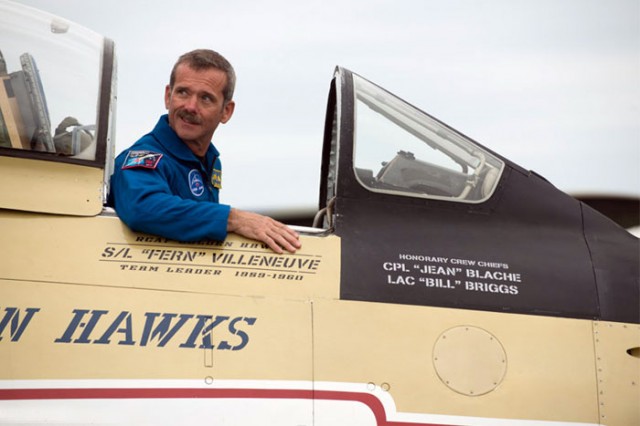
Chris Hadfield at the controls of a Sabre Mk.5 – Photo: Peter Handley | VWoC
Hadfield’s beginnings were rather humble. The son of a farmer and pilot, he would regularly go flying with his father, and when he was nine, one world changing event would alter his life. “It was while I was sitting on the floor of our summer cottage, watching Neil Armstrong set foot on the Moon for the first time, that I knew I wanted to fly into space. I decided to devote my life at that point to trying to fly into space,” he states in his book, An Astronaut’s Guide to Life on Earth.
Following college, he became a pilot with the Royal Canadian Air Force, flying CF-18 Hornets. During his time on active duty, he flew a few firsts: “I flew the first intercept of a Soviet bomber in the CF-18,” he says. “It was my very first night on alert, and we scrambled out of Newfoundland and intercepted the aircraft out over the Atlantic and shadowed it to ensure it was not hostile.”
With flying in the Hadfield family blood, Chris still flies whenever he has the chance, and when asked what his favorite plane is, his reply comes quick and easy: “I’ve flown over 100 types of aircraft, but my favorite has to be the Canadair Sabre. Nothing really comes close to it. I fly one off and on for the Vintage Wings of Canada, and it is a thrill every time I strap in. It is like having a pair of wings strapped on your back and unlimited freedom. Yes, the CF-18 and T-38 are great aircraft, very maneuverable and fast, but the Sabre is pure flying.”
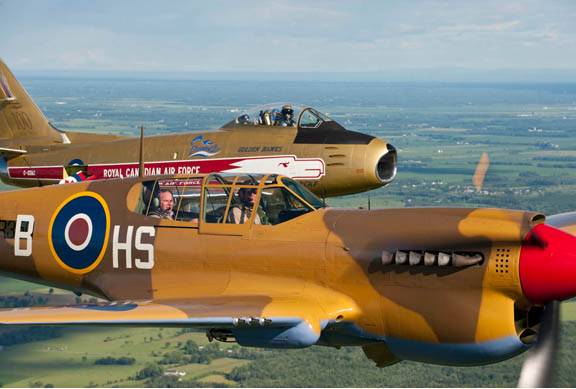
Chris Hadfield, in the Sabre, flies formation with his brother, David, in a P-40, with their father in the back seat. Photo: Peter Handley | VWoC
On his last mission, he became famous for his social media use. “I decided that I was not going to try and keep the experience of flying into space for myself. I wanted to use whatever I could to share my experiences with the world,” Hadfield said. “Just prior to my stay on the ISS, NASA finally figured out how to get regular, limited internet access on the station. So I thought that it would be a great way to invite everyone on board with us, and I took advantage of it. I didn’t have much time on board to put out tweets and such, but I made sure I took a few minutes a day to do it. When I landed we had over a million followers on Twitter.”
During his time on board the ISS, Hadfield would go on to post hundreds of photos giving everyone back on Earth a glimpse of what he was seeing and doing. He also did several educational videos, most of which were published on YouTube. His most well-known feat, however, would be singing in space. “I recorded a song that my brother wrote, called Jewel in the Night, and I believe that that was the first song to be recorded in space,” he says. “I did a recording with Ed Robinson of Barenaked Ladies, and we had over a million school kids from all over Canada join in. It was a really impressive feat.”
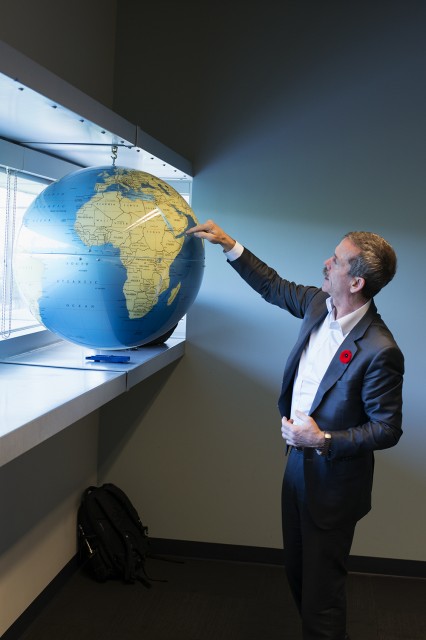
Canadian astronaut Chris Hadfield describes features of the planet while giving a talk at the Future of Flight – Photo: Kris Hull
Hadfield’s most famous video, though, was his rendition of David Bowie’s Space Oddity. The story of how Space Oddity came to be is a jewel in itself: “After I got to the space station, I recorded Jewel in the Night, and my son Evan put it up on SoundCloud. within a few weeks, we had over one hundred thousand hits on that song. Evan reminded me that I had many requests to sing Space Oddity, and said that I really need to do this.” Hadfield recalled.
“So I learned it, and in roughly an hour and a half, I recorded the vocals on GarageBand on my iPad, and with the help of one of the crew up there with me shot the video. I then sent it down to Evan with help from the CSA and NASA. We talked with Bowie’s representatives, and got him on board, and had several other musicians help with the project. It was just through shear coincidence that it was released the day before I returned, and has since been seen over 150 million times. David Bowie himself saw it and commented that it was the most poignant rendition of the song he heard, and he loved it! Not too bad for what was just a weekend father/son project.”
Due to copyright and intellectual property issues, Hadfield’s agreement with Bowie was only good for a year, and in May of 2014, he pulled the video down. Talks went on, though, and at the end of October, a new, two-year agreement was reached. Hadfield was proud to say that Bowie was back!
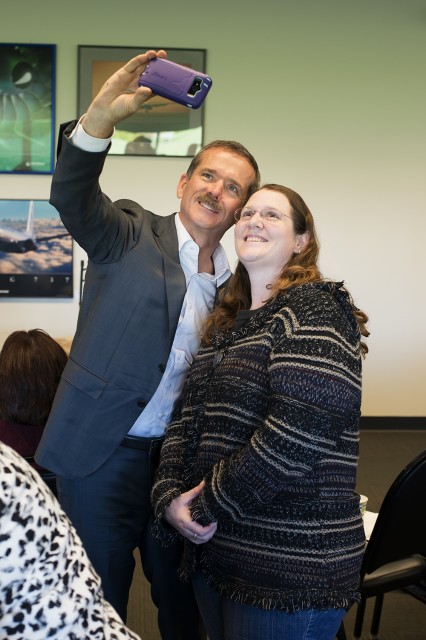
Canadian astronaut Chris Hadfield takes a “selfie” with a guest at the Future of Flight Photo: Kris Hull
Aside from his missions and experiences, Hadfield is adamant that space flight continue. In response to the recent incidents in Virgina with an Antares rocket failing, and in California with Virgin Galactic’s SpaceShipTwo crashing on a test flight, he commented: “If you go back and look at history, where would we be if after the first ship sank, we stopped all ocean commerce, if after Titanic, we said ‘It’s too dangerous. We need to stop’. Where would we be? Countless hundreds, maybe thousands of people died in the pursuit of safe air travel, and many times more than that died in the pursuit of sea travel. We need to ensure that we carry on, and we do go the next step. It is human nature to explore, and we need to enable that.”
When asked about what is next in space, he added “Many want to go to Mars, and I think that is a worthy goal. However, I feel that our next logical step is to return to the Moon and colonize it. We can learn a lot from long-duration stays there, and we can develop and mature the technologies that are needed for going to Mars. I feel that the technology is not there yet to facilitate a manned trip to Mars. Maybe in fifty years, but not now. We need better rockets and spacecraft first, and we have a perfect place to test and develop those just three days away with the moon. If we send people to Mars now, we will end up killing them.”
On November 8th, Chris Hadfield gave a presentation to a sold-out group of 400 people at Everett’s Future of Flight where he talked about his experiences, and also spoke about his latest book. You are Here is a collection of two hundred of the nearly 148,000 photos of the Earth that he took while in orbit.
“I wanted to give every person the opportunity to see the Earth as I saw it. To take in its beauty and grandeur,” he told the crowd. “The images in this book are to represent one complete orbit around the globe. A few weeks ago I had a reporter ask me which one was my favorite. I told him ‘well, I took nearly 150,000 while on the station, and I narrowed it down to 200 for this book, so that are all my favorite!”
The Colonel also served a point of stressing the importance of education and never giving up. On person in attendance, Dr. Karen Ried, who is the principal of Serene Lake Elementary School in nearby Mukilteo, WA, showed up to the event in her Space Academy flight suit that she received when she attended as an educator several years ago.
“Hearing Commander Hadfield today at the Future of Flight and meeting him in person was a thrill and I will take back my excitement to our students at school – especially our students in our Aviation Club,” she said. It was a sentiment that was shared by many in attendance. Being ever so humble and generous, Hadfield made it a point to personally meet with every one who attended the event, and ended up staying over an hour past his planned departure time. The attendees, however, were very grateful, as they lined up for over ninety minutes to have their books signed and meet him.
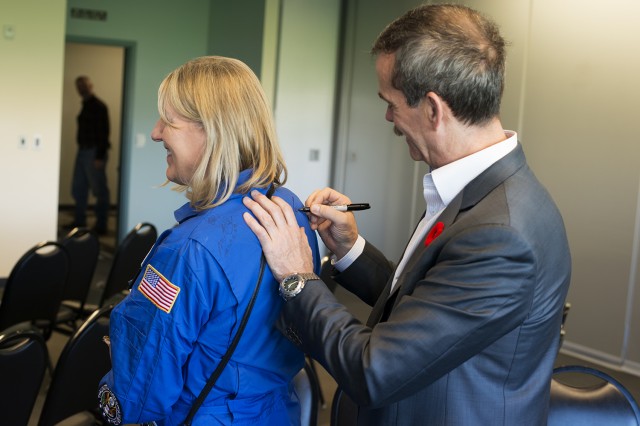
Dr. Karen Reid, principal of Seren Lake Elementary has her flight suit signed by astronaut Chris Hadfield – Photo: Kris Hull
Take a minute now to view the Earth as seen from orbit as shown by a few of Col. Hadfield’s amazing and stunning photos.
Comments are closed here.
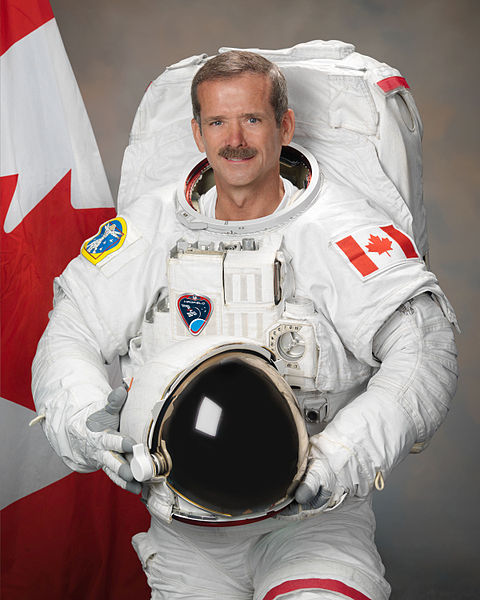
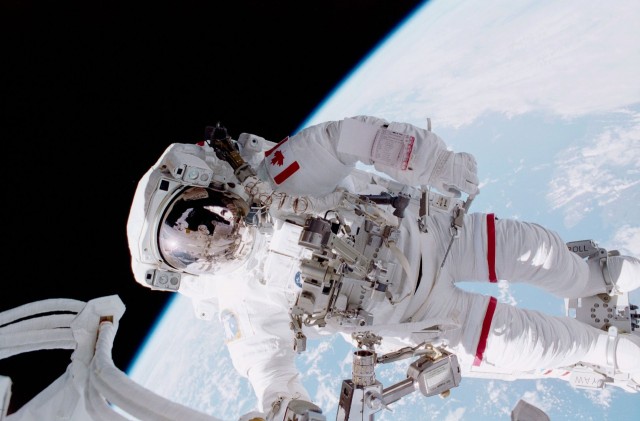
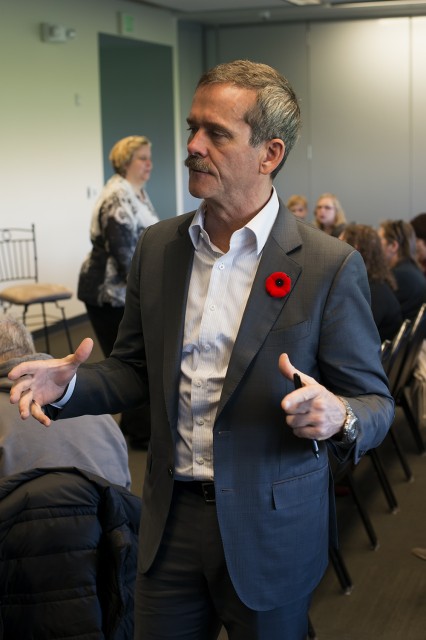
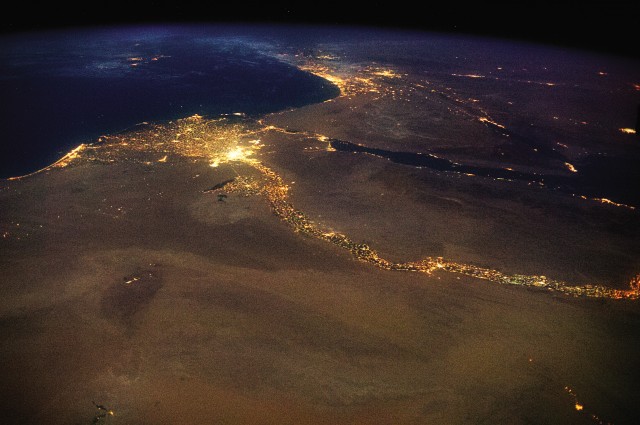
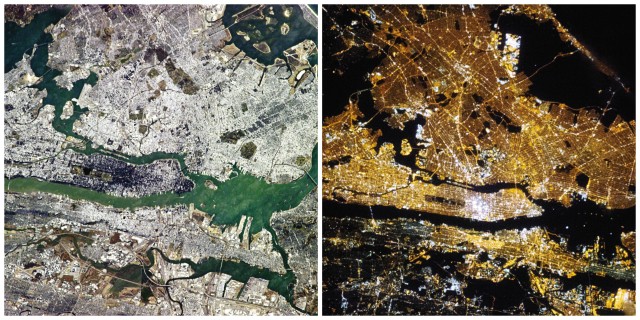
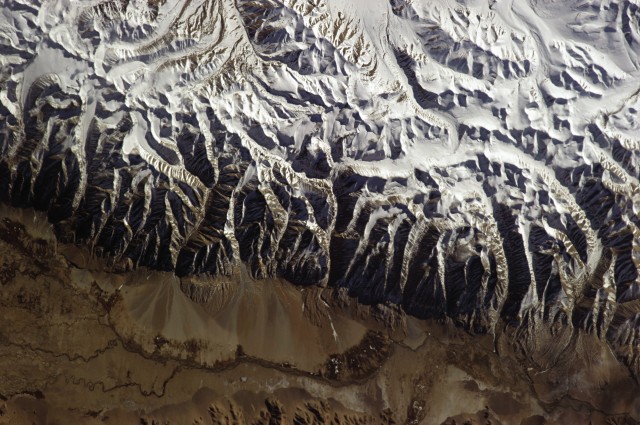
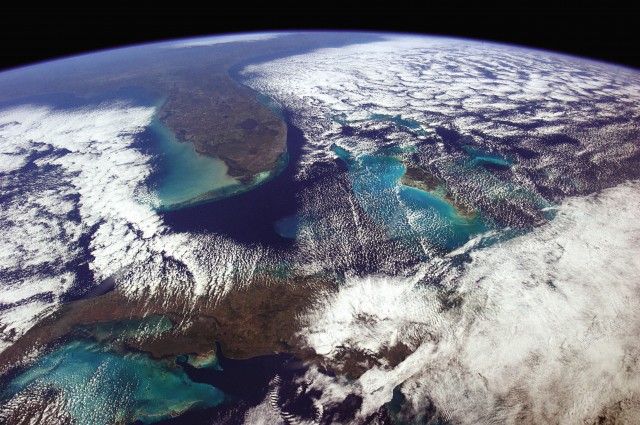
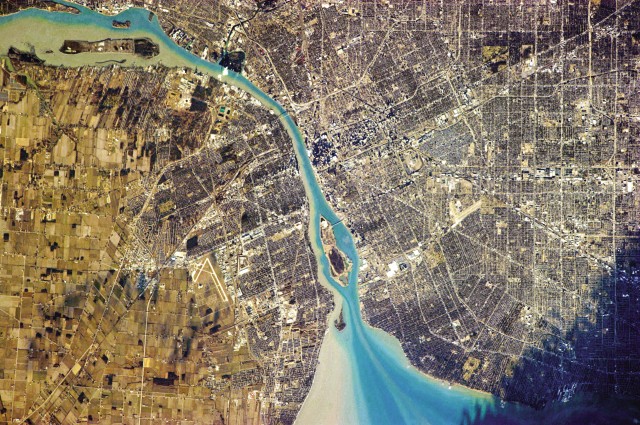
Chris Hadfield is the best.
btw – Windsor is on the left and Detroit is on the right…
I believe that it is Windsor to the left (South) and Detroit to the right (North) 🙂
Thanks @James and @Rune – FIXED